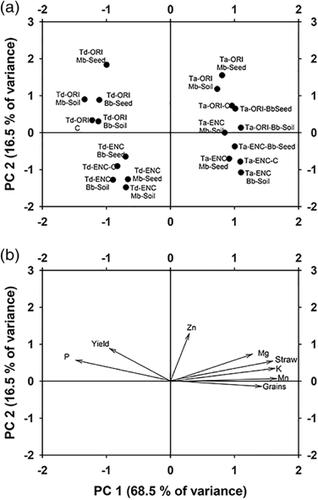当前位置:
X-MOL 学术
›
Ann. Appl. Biol.
›
论文详情
Our official English website, www.x-mol.net, welcomes your feedback! (Note: you will need to create a separate account there.)
Effects of entomopathogenic fungi on growth and nutrition in wheat grown on two calcareous soils: Influence of the fungus application method
Annals of Applied Biology ( IF 2.6 ) Pub Date : 2020-05-13 , DOI: 10.1111/aab.12596 Adrián González‐Guzmán 1 , Daniel Sacristán 1 , Enrique Quesada‐Moraga 1 , José Torrent 1 , María Carmen Campillo 1 , Antonio Rafael Sánchez‐Rodríguez 1
Annals of Applied Biology ( IF 2.6 ) Pub Date : 2020-05-13 , DOI: 10.1111/aab.12596 Adrián González‐Guzmán 1 , Daniel Sacristán 1 , Enrique Quesada‐Moraga 1 , José Torrent 1 , María Carmen Campillo 1 , Antonio Rafael Sánchez‐Rodríguez 1
Affiliation

|
Entomopathogenic fungi (EF) have so far aroused little interest as plant growth promoters or nutritional enhancers while protecting the plant against insect pests and mites. In this work, we examined the performance of Triticum durum and Triticum aestivum plants pot‐grown on two unsterilized Zn‐poor calcareous Vertisols and inoculated with Beauveria bassiana or Metarhizium brunneum by application to soil or seed dressing. The effects of fungal inoculation were found to depend on crop species, soil type, sampling time and fungus application method. While the height of the control plants tended to be significantly greater than the height of inoculated plants at early and intermediate growth stages, the trend changed at more advanced plant stage of development, 56 days after sowing (DAS). This was supported by the significant increase in aerial dry matter (ADM) in T. aestivum plants treated with B. bassiana by seed dressing (17.4%) or with M. brunneum with soil application and seed dressing (20.6 and 26.9%, respectively) 69 DAS. In T. durum, at harvest, seed dressing with B. bassiana or M. brunneum had an overall positive but not significant effect on ADM or grain yield, whereas direct application to the soil slightly decreased grain yield (6.6 and 5.5%, respectively) and ADM (5.3 and 6.1%, respectively). In T. aestivum, none of the fungus–application method combinations affected yield at harvest significantly. Fungal inoculation had little influence on nutrient uptake, whereas application to soil increased Mn uptake and grain Mn concentration in T. durum. Zinc uptake was significantly increased only in T. aestivum grown on the soil with the lowest Zn content treated with M. brunneum. Grain Zn concentration tended to be inversely related to grain yield. These results support seed dressing with EF as a promising green technology for sustainable crop protection and production with no adverse effects on plant performance.
中文翻译:

昆虫病原真菌对两种钙质土壤小麦生长和营养的影响:真菌施用方法的影响
迄今为止,致病性真菌(EF)作为植物生长促进剂或营养增强剂,同时又能保护植物免受害虫和螨虫的侵害,引起了人们的兴趣。在这项工作中,我们研究了在两种未经消毒的贫锌钙质Vertisols上种植并接种了球孢白僵菌或Berverhizium brunneum的硬粒小麦和普通小麦的性能。应用于土壤或拌种。发现真菌接种的影响取决于作物种类,土壤类型,采样时间和真菌施用方法。尽管对照植物的高度倾向于在生长的早期和中期阶段大大高于接种植物的高度,但这种趋势在播种后56天(DAS)的更高级植物发育阶段发生了变化。这通过以下方式得到支持:在球孢白僵菌中,通过拌种(17.4%)或用土壤施用和拌种(分别为20.6%和26.9%)的布鲁氏杆菌处理的普通小麦中的空气干物质(ADM)显着增加。69 DAS。在硬粒小麦中,收获时,用球孢白僵菌或brunneumum对ADM或谷物产量总体上具有积极影响,但没有显着影响,而直接施用到土壤上则使谷物产量(分别为6.6和5.5%)和ADM(分别为5.3和6.1%)略有降低。在普通小麦中,没有任何一种真菌-施用方法的组合对收获时的产量有显着影响。真菌接种对养分的吸收影响很小,而施于土壤则增加了硬粒小麦的锰吸收和籽粒锰含量。锌的吸收仅在生长于土壤中的小麦中具有最低锌含量的小麦中才会显着增加。籽粒锌的浓度往往与籽粒产量成反比。这些结果支持EF拌种作为一种有前途的绿色技术,可用于可持续的作物保护和生产,而不会对植物生长造成不利影响。
更新日期:2020-05-13
中文翻译:

昆虫病原真菌对两种钙质土壤小麦生长和营养的影响:真菌施用方法的影响
迄今为止,致病性真菌(EF)作为植物生长促进剂或营养增强剂,同时又能保护植物免受害虫和螨虫的侵害,引起了人们的兴趣。在这项工作中,我们研究了在两种未经消毒的贫锌钙质Vertisols上种植并接种了球孢白僵菌或Berverhizium brunneum的硬粒小麦和普通小麦的性能。应用于土壤或拌种。发现真菌接种的影响取决于作物种类,土壤类型,采样时间和真菌施用方法。尽管对照植物的高度倾向于在生长的早期和中期阶段大大高于接种植物的高度,但这种趋势在播种后56天(DAS)的更高级植物发育阶段发生了变化。这通过以下方式得到支持:在球孢白僵菌中,通过拌种(17.4%)或用土壤施用和拌种(分别为20.6%和26.9%)的布鲁氏杆菌处理的普通小麦中的空气干物质(ADM)显着增加。69 DAS。在硬粒小麦中,收获时,用球孢白僵菌或brunneumum对ADM或谷物产量总体上具有积极影响,但没有显着影响,而直接施用到土壤上则使谷物产量(分别为6.6和5.5%)和ADM(分别为5.3和6.1%)略有降低。在普通小麦中,没有任何一种真菌-施用方法的组合对收获时的产量有显着影响。真菌接种对养分的吸收影响很小,而施于土壤则增加了硬粒小麦的锰吸收和籽粒锰含量。锌的吸收仅在生长于土壤中的小麦中具有最低锌含量的小麦中才会显着增加。籽粒锌的浓度往往与籽粒产量成反比。这些结果支持EF拌种作为一种有前途的绿色技术,可用于可持续的作物保护和生产,而不会对植物生长造成不利影响。



























 京公网安备 11010802027423号
京公网安备 11010802027423号